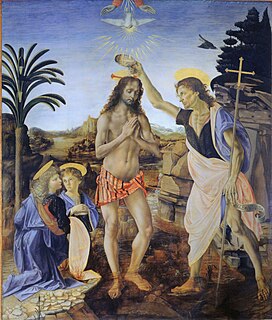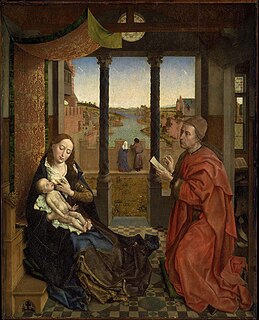
Jean-Baptiste-Camille Corot was a French landscape and portrait painter as well as a printmaker in etching. He is a pivotal figure in landscape painting and his vast output simultaneously referenced the Neo-Classical tradition and anticipated the plein-air innovations of Impressionism.

Oswald Achenbach was a German painter associated with the Düsseldorf school of painting. Though little known today, during his lifetime he was counted among the most important landscape painters of Europe. Through his teaching activities, he influenced the Kunstakademie Düsseldorf. His brother, Andreas Achenbach, who was twelve years older, was also among the most important German landscape painters of the 19th century. The two brothers were humorously called "the A and O of Landscapes".

Pierre Bonnard was a French painter, illustrator and printmaker, known especially for the stylized decorative qualities of his paintings and his bold use of color. A founding member of the Post-Impressionist group of avant-garde painters Les Nabis, his early work was strongly influenced by the work of Paul Gauguin, as well as the prints of Hokusai and other Japanese artists. Bonnard was a leading figure in the transition from Impressionism to Modernism. He painted landscapes, urban scenes, portraits and intimate domestic scenes, where the backgrounds, colors and painting style usually took precedence over the subject.

Color field painting is a style of abstract painting that emerged in New York City during the 1940s and 1950s. It was inspired by European modernism and closely related to abstract expressionism, while many of its notable early proponents were among the pioneering abstract expressionists. Color field is characterized primarily by large fields of flat, solid color spread across or stained into the canvas creating areas of unbroken surface and a flat picture plane. The movement places less emphasis on gesture, brushstrokes and action in favor of an overall consistency of form and process. In color field painting "color is freed from objective context and becomes the subject in itself."

Le Déjeuner sur l'herbe – originally titled Le Bain – is a large oil on canvas painting by Édouard Manet created in 1862 and 1863. It depicts a female nude and a scantily dressed female bather on a picnic with two fully dressed men in a rural setting. Rejected by the Salon jury of 1863, Manet seized the opportunity to exhibit this and two other paintings in the 1863 Salon des Refusés, where the painting sparked public notoriety and controversy. The work is now in the Musée d'Orsay in Paris. A smaller, earlier version can be seen at the Courtauld Gallery, London.

Frederick Childe Hassam was an American Impressionist painter, noted for his urban and coastal scenes. Along with Mary Cassatt and John Henry Twachtman, Hassam was instrumental in promulgating Impressionism to American collectors, dealers, and museums. He produced over 3,000 paintings, oils, watercolors, etchings, and lithographs over the course of his career, and was an influential American artist of the early 20th century.

Henry Ward Ranger was an American artist. Born in western New York State, he was a prominent landscape and marine painter, an important Tonalist, and the leader of the Old Lyme Art Colony. Ranger became a National Academician (1906), and a member of the American Water Color Society. Among his paintings are, Top of the Hill, Corcoran Gallery of Art, Washington, D.C.; and East River Idyll, Carnegie Institute, Pittsburgh, Pennsylvania.

The Baptism of Christ is a painting finished around 1475 in the studio of the Italian Renaissance painter Andrea del Verrocchio and generally ascribed to him and his pupil Leonardo da Vinci. Some art historians discern the hands of other members of Verrocchio's workshop in the painting as well.
Živko Stojsavljević was a Serbian painter.

The history of Western painting represents a continuous, though disrupted, tradition from antiquity until the present time. Until the mid-19th century it was primarily concerned with representational and Classical modes of production, after which time more modern, abstract and conceptual forms gained favor.

Nicola Simbari was an Italian painter.

Saint Luke painting the Virgin,, is a devotional subject in art showing Luke the Evangelist painting the Virgin Mary with the Child Jesus. Such paintings were often created during the Renaissance for chapels of Saint Luke in European churches, and frequently recall the composition of the Salus Populi Romani, an icon based on the legend of Luke's portrait of Mary. Versions of the subject were sometimes painted as the masterpiece that many guilds required an artist to submit before receiving the title of master.
Antonietta Brandeis (1848–1926), was a Czech-born Italian landscape, genre and portrait painter, as well as a painter of religious subjects for altarpieces.
Tonal Impressionism was an artistic style of "mood" paintings with simplified compositions, done in a limited range of colors, as with Tonalist works, but using the brighter, more chromatic palette of Impressionism. An exhibition titled "Tonal Impressionism" was curated by the art historian Harry Muir Kurtzworth for the Los Angeles Art Association Gallery at the Los Angeles Central Library in June 1937 with the works of a number of prominent California artists. In recent years, the term has also been used to describe a non-linear approach to painting where the subject is massed in with tonal values without the use of underdrawing.

Look Mickey is a 1961 oil on canvas painting by Roy Lichtenstein. Widely regarded as the bridge between his abstract expressionism and pop art works, it is notable for its ironic humor and aesthetic value as well as being the first example of the artist's employment of Ben-Day dots, speech balloons and comic imagery as a source for a painting. The painting was bequeathed to the Washington, D.C., National Gallery of Art upon Lichtenstein's death.

Allen Butler Talcott was an American landscape painter. After studying art in Paris for three years at Académie Julian, he returned to the United States, becoming one of the first members of the Old Lyme Art Colony in Connecticut. His paintings, usually landscapes depicting the local scenery and often executed en plein air, were generally Barbizon and Tonalist, sometimes incorporating elements of Impressionism. He was especially known and respected for his paintings of trees. After eight summers at Old Lyme, he died there at the age of 41.

Karl Walther was a painter of the German Post-Impressionist school, and an exponent of plein air painting. His works include portraits, still lifes, cityscapes and landscape paintings.
James Joseph DeMartis was an American painter of the post-World War II generation who explored a wide variety of styles and media; he is best known for his abstract expressionist works.

Interior with an Easel, Bredgade 25 is an oil-on-canvas painted by Danish artist Vilhelm Hammershøi in 1912. Acquired by the Getty Museum in 2018, the painting depicts the artist's apartment at Bredgade 25 in Copenhagen, which was his address up to his death in 1916.

John Opper (1908–1994) was an American painter who transitioned from semi-abstract paintings in the late 1930s to fully abstract ones in the 1950s. He became known for his handling of color and in particular his ability to create dramatic intensity on the picture plane by means of juxtaposed, more-or-less rectangular areas of color. He was associated with the abstract expressionist movement and frequently showed in galleries that specialized in abstract expressionist art. Late in life, he described his style by what it was not. He said, "The whole is the sum of its parts. That's what my school of abstract art is about, a school that evolved from nature, not conceptual, not geometric, not hard-edged. It's only art."

















